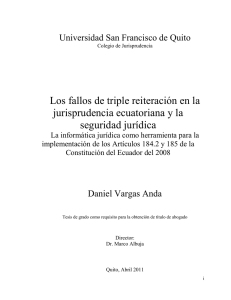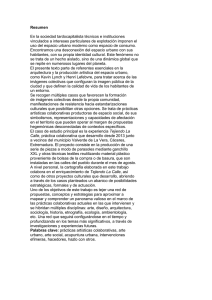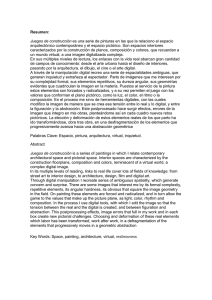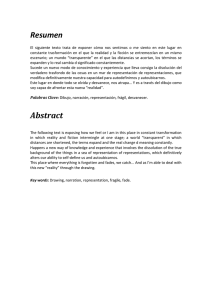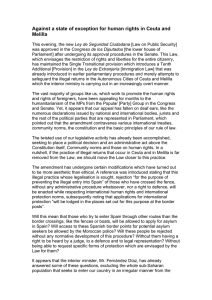Nuestros lectores de números anteriores, saben que - POLI-RED
Anuncio
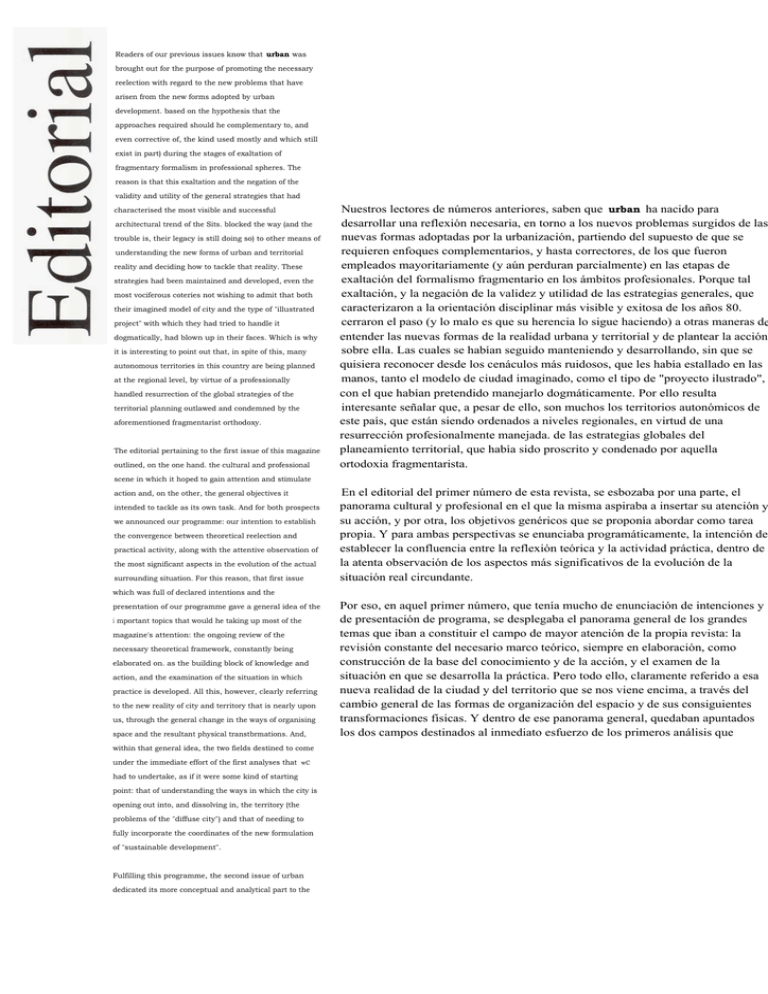
Readers of our previous issues know that urban was brought out for the purpose of promoting the necessary reelection with regard to the new problems that have arisen from the new forms adopted by urban development. based on the hypothesis that the approaches required should he complementary to, and even corrective of, the kind used mostly and which still exist in part) during the stages of exaltation of fragmentary formalism in professional spheres. The reason is that this exaltation and the negation of the validity and utility of the general strategies that had characterised the most visible and successful architectural trend of the Sits. blocked the way (and the trouble is, their legacy is still doing so) to other means of understanding the new forms of urban and territorial reality and deciding how to tackle that reality. These strategies had been maintained and developed, even the most vociferous coteries not wishing to admit that both their imagined model of city and the type of "illustrated project" with which they had tried to handle it dogmatically, had blown up in their faces. Which is why it is interesting to point out that, in spite of this, many autonomous territories in this country are being planned at the regional level, by virtue of a professionally handled resurrection of the global strategies of the territorial planning outlawed and condemned by the aforementioned fragmentarist orthodoxy. The editorial pertaining to the first issue of this magazine outlined, on the one hand. the cultural and professional Nuestros lectores de números anteriores, saben que urban ha nacido para desarrollar una reflexión necesaria, en torno a los nuevos problemas surgidos de las nuevas formas adoptadas por la urbanización, partiendo del supuesto de que se requieren enfoques complementarios, y hasta correctores, de los que fueron empleados mayoritariamente (y aún perduran parcialmente) en las etapas de exaltación del formalismo fragmentario en los ámbitos profesionales. Porque tal exaltación, y la negación de la validez y utilidad de las estrategias generales, que caracterizaron a la orientación disciplinar más visible y exitosa de los años 80. cerraron el paso (y lo malo es que su herencia lo sigue haciendo) a otras maneras de entender las nuevas formas de la realidad urbana y territorial y de plantear la acción sobre ella. Las cuales se habían seguido manteniendo y desarrollando, sin que se quisiera reconocer desde los cenáculos más ruidosos, que les había estallado en las manos, tanto el modelo de ciudad imaginado, como el tipo de "proyecto ilustrado", con el que habían pretendido manejarlo dogmáticamente. Por ello resulta interesante señalar que, a pesar de ello, son muchos los territorios autonómicos de este país, que están siendo ordenados a niveles regionales, en virtud de una resurrección profesionalmente manejada. de las estrategias globales del planeamiento territorial, que había sido proscrito y condenado por aquella ortodoxia fragmentarista. scene in which it hoped to gain attention and stimulate action and, on the other, the general objectives it intended to tackle as its own task. And for both prospects we announced our programme: our intention to establish the convergence between theoretical reelection and practical activity, along with the attentive observation of the most significant aspects in the evolution of the actual surrounding situation. For this reason, that first issue En el editorial del primer número de esta revista, se esbozaba por una parte, el panorama cultural y profesional en el que la misma aspiraba a insertar su atención y su acción, y por otra, los objetivos genéricos que se proponía abordar como tarea propia. Y para ambas perspectivas se enunciaba programáticamente, la intención de establecer la confluencia entre la reflexión teórica y la actividad práctica, dentro de la atenta observación de los aspectos más significativos de la evolución de la situación real circundante. which was full of declared intentions and the presentation of our programme gave a general idea of the i mportant topics that would he taking up most of the magazine's attention: the ongoing review of the necessary theoretical framework, constantly being elaborated on. as the building block of knowledge and action, and the examination of the situation in which practice is developed. All this, however, clearly referring to the new reality of city and territory that is nearly upon us, through the general change in the ways of organising space and the resultant physical transtbrmations. And, within that general idea, the two fields destined to come under the immediate effort of the first analyses that wC had to undertake, as if it were some kind of starting point: that of understanding the ways in which the city is opening out into, and dissolving in, the territory (the problems of the "diffuse city") and that of needing to fully incorporate the coordinates of the new formulation of "sustainable development". Fulfilling this programme, the second issue of urban dedicated its more conceptual and analytical part to the Por eso, en aquel primer número, que tenía mucho de enunciación de intenciones y de presentación de programa, se desplegaba el panorama general de los grandes temas que iban a constituir el campo de mayor atención de la propia revista: la revisión constante del necesario marco teórico, siempre en elaboración, como construcción de la base del conocimiento y de la acción, y el examen de la situación en que se desarrolla la práctica. Pero todo ello, claramente referido a esa nueva realidad de la ciudad y del territorio que se nos viene encima, a través del cambio general de las formas de organización del espacio y de sus consiguientes transformaciones físicas. Y dentro de ese panorama general, quedaban apuntados los dos campos destinados al inmediato esfuerzo de los primeros análisis que study of this "diffuse" reality at which the city region or citta territorio has ended up, with a number of lucid approaches to the analysis of the forms that the new urban and territorial condition of the post-metropo/i.s, post-suburb and post-periphery is taking on and taking debíamos realizar, como si se tratase casi de un punto de partida: el de la comprensión de las formas en que se está produciendo la apertura y disolución de la ciudad en el territorio. (la problemática de la "ciudad difusa") y el de la necesidad de la incorporación plena de las coordenadas de la nueva formulación del r "desar ollo sostenible". shape from. Approaches which are already effectively helping us to understand, assimilate and show that new reality, and how to deal with it. Now. continuing in line with the programme, this third issue of the magazine broaches the "sustainahility" theme, approaching it as an expansion of environmental awareness, from one's own space to the more distant surroundings (the ecological imprint), but also as an Cumpliendo ese programa. el segundo número de urban dedicó su parte más conceptual y analítica al estudio de esta realidad "difusa", a la que ha venido a parar la city region o la citui territorio, con una serie de aproximaciones lúcidas al análisis de esas formas que está adoptando, y en las cuales se está configurando, la nueva condición urbana y territorial de la postrnetrópolis, el postsuburbio y la postperiferia. Aproximaciones que nos están proporcionando ya, ayuda eficaz para comprender, asimilar y enseñar esa nueva realidad, y las formas de abordar su tratamiento. inevitable dimension of local planning which is now finding new support from the ecological understanding of our physical surroundings. Because while this planning was always ahead in its theories and intentions for protecting the balance of nature and the countryside, it had never seen those protective aspirations, along with so many others which are also now being vindicated from other fronts, respected. But this does not mean that one should ignore the new dangers stemming from the "pulverisation" of what is urban. an inherent characteristic of the "diffuse" city, as these dangers may, in addition. be multiplied by the situation defined recently by Spain's new town planning regulations. Our magazine does not concentrate solely and exclusively on the highest plane of conceptual thinking. On the contrary, it has shown an interest right from the start - and this too forms part of its programme -, in the ups and downs of the changing legal situation, the provisions of which are of vital importance for the development of town planning activity. The first issue of urban referred to the situation created by the controversial sentence (then recent) of the Constitutional Court. which annulled most of the State law of 1990. It also tackled the issue of the reform of town planning legislation, already undertaken at that time, considering Y siguiendo con el cumplimiento del programa, es ahora en el tercer número de la revista, cuando se aborda el tema de la "sostenibilidad", enfocado como ampliación de la conciencia medioambiental, desde el espacio propio al entorno lejano (la huella ecológica), pero también como dimensión ineludible del planeamiento local, el cual se encuentra ahora con los nuevos apoyos que le llegan del entendimiento ecológico del medio físico. Porque si bien fue siempre adelantado en sus formulaciones teóricas e intencionales de protección del equilibrio natural y del medio rural, no había podido ver respetadas, como tantas otras, esas aspiraciones protectoras, que ahora se ven reivindicadas desde otros frentes. Pero esto no supone ignorar los nuevos peligros, derivados de la "pulverización" de lo urbano, propia de esa ciudad "difusa", que además, pueden ser multiplicados por la situación que ha definido recientemente, la nueva regulación jurídica del urbanismo en el país. Porque la revista no se mantiene exclusivamente en el plano más elevado de la reflexión conceptual. sino que se ha interesado también desde el primer momento, y ello forma parte de su programa, por los avatares de una cambiante situación legal. cuyas formulaciones son de importancia fundamental para el desarrollo de la actividad urbanística. En el número I de urban, aparecía la referencia a la situación creada por la polémica sentencia (entonces reciente) del Tribunal Constitucional, que anulaba la mayor parte de la ley estatal de 1990. Y se abordaba también en él, la cuestión de la reforma de la legislación urbanística, ya entonces emprendida, considerando que se había terminado el período histórico que había estado presidido por el modelo legislativo de 1956. Es este un tema clave, del que la revista no puede desentenderse y sobre el cual habrá de volver, porque la situación actual, producto de hechos posteriores, es de confusa provisionalidad. the fact that the historical period covered by the legislative model of 1956 had ended. This is a vital issue on which the magazine cannot affect ignorance and to which it will be necessary to return, because the present situation, the result of things that occurred later, is one of confused provisionality. As is well known, there had been a fair amount of legislative unity up until that time, despite the Constitution having entirely passed the jurisdiction on this matter over to the autonomous governments. The Law of 1976 (reforming that of 1956) had been adopted after the political transition to Democracy by all the autonomous communities, without any technical or political protests, and only some exceptions (Catalonia. Galicia, Madrid, Navarre and Valencia) later approved, in the 80s and 90s, their respective new town planning legislation, clearly respecting (except in the case of Valencia) the aforesaid State law, which had been included almost in its entirety by the Catalan law and Como es sabido, había existido bastante unidad legislativa hasta entonces, a pesar del completo traspaso de competencias que, en esa materia, había hecho la Constitución, a favor de los gobiernos autónomos. La Ley de 1976 (reforma de la de 1956) había sido adoptada, después de la transición política a la Democracia, por todas las comunidades autónomas, sin protestas técnicas ni políticas, y sólo algunas excepciones (Cataluña. Galicia, Madrid. Navarra y Valencia) fueron aprobando luego, ya en los años 80 y 90. sus respectivas legislaciones urbanísticas nuevas, con evidente respeto (excepto en el caso valenciano) hacia la citada ley explicitly praised in the Basque Country's bill. The State law remained in force for all the other communities until it was replaced by that of 1990, also a State-wide law which, on the other hand, served as a reference for i mportant parts of the aforementioned autonomous laws that were passed after it. But that law of 1990, which is undoubtedly a grave mistake of the Socialist period and the result of irresponsible ignorance, caused such a reaction that, apart from its never actually being applied, it was contested before the Constitutional Court and appealed against in the Supreme Court by several autonomous governments which, upset by the rigid demands introduced by the law. correcting the subtle flexibility brought in by the 1976 law. hoisted the flag of unconstitutionality owing to the invasion of legislative estatal, que había sido asumida casi íntegramente por la catalana y elogiada explícitamente en el Proyecto de la del País Vasco. Para todas las demás comunidades seguía vigente aquella ley estatal, hasta que fue sustituida por la de 1990, también de ámbito estatal que, por otra parte, sirvió de remisión a partes importantes de aquellas leyes autonómicas citadas, que fueron aprobadas después de ella. Pero esa ley de 1990, que sin duda es un error grave de la etapa socialista y fruto de irresponsable desconocimiento, provocó una reacción tal que, aparte de no llegar a ser aplicada nunca, fue impugnada ante el Tribunal Constitucional y recurrida ante el Supremo por varios gobiernos autónomos que, disgustados por las exigencias rigidizadoras introducidas por dicha ley, corrigiendo la matizada Ilexibilidad introducida por la ley de 1976, enarbolaron la bandera de la inconstitucionalidad por invasión de competencias legislativas. El resultado fue la citada sentencia, que en 1997, anulaba gran parte de la ley de 1990, y negaba al Estado toda posibilidad de legislar en materia urbanística, excepto en lo que sobre ella pudiera incidir la regulación del derecho de propiedad del suelo. powers. The result was the aforesaid sentence which in 1997 cancelled a large part of the 1990 law and denied the State any possibility of legislating on town planning matters, except insofar as regulation of the right of land ownership might he concerned. And it was based on this exception that the 1998 State Law on the Land and Valuations Scheme, clearly of a more liberal slant, along with a number of autonomous laws that were hurried through for the purpose of filling the legal vacuum left by the annulment of the 1991) law on which, as we have already mentioned, some of the autonomous legislation of the 90s had rested, appeared rapidly on the scene. That is why the present situation is, in effect, one of confusion and provisionality, as the nonannulled remains of the previous State legislation are coexisting with the new autonomous laws and with the new State legislation. But apart from this. the most i mportant thing is that the central administration has Y es con apoyo en esta excepción, como ha surgido rápidamente la ley estatal sobre Régimen del Suelo y Valoraciones de 1998, de corte claramente liberalizador, así como un conjunto de apresuradas legislaciones autonómicas, nacidas para llenar el vacío legal dejado por la anulación de la ley de 1990, en la que se habían apoyado, como hemos dicho, algunas de las legislaciones autonómicas de los años 90. Por ello, la situación actual es, efectivamente, de confusión y provisionalidad, ya que coexisten ahora los restos de la legislación estatal anterior no anulados, con las legislaciones autonómicas nuevas y con la nueva legislación estatal. Pero aparte de ello, lo más importante es que, desde la administración central, se ha aprovechado la ocasión para que esa nueva legislación estatal, por la vía de la regulación de la propiedad del suelo, establezca un nuevo sistema de funcionamiento de los planes de urbanismo, en el que se invierte la fórmula tradicional en el sistema de planeamiento utilizado hasta ahora en España. Ya no se trata de que el plan, en función de las expectativas de crecimiento y de los programas municipales, calcule, determine y delimite el único suelo que deberá reservarse (con holguras en las versiones matizadas) para ser ocupado por ese desarrollo, sino que una vez excluido el suelo que no debe ser ocupado, por poseer recursos naturales que deben ser preservados, el resto es potencialmente urbanizable por sus propietarios. taken this opportunity to see that the new State legislation, via regulation of land ownership. establishes a new system of operation of the urban development plans. in which the traditional formula in the planning system used up to now in Spain, is inverted. It is no longer a question of the plan calculating. determining and demarcating the only land that must he reserved ( with some leeway in the detailed versions) for occupation by that development. depending on growth Está clara la magnitud del cambio producido. La intención liberalizadora ha dado la vuelta conceptualmente, al sistema restrictivo anterior, consustancial con el planeamiento urbanístico tradicional. ¿Qué va a pasar ahora con un sistema de uso del suelo tan diferente del utilizado hasta ahora? Es evidente que se ha abierto un nuevo capítulo en el que los ayuntamientos, a través de los planes de ordenación urbana (pronto oiremos hablar de una nueva generación de ellos) tienen nuevamente el protagonismo. He ahí un nuevo campo de reflexión perentoria para urban. expectations and municipal programmes, but of the land that is left after exclusion of that which is not to be • occupied because it has natural resources that must he preserved, being potentially developable by the owners. 4 The extent of the change is quite clear. The liberalising intention has turned the concepts of the precious restrictive system, which were consistent with traditional town planning. head over heels. What is going to happen now with a system of land use so different from that used up to now'? It is obvious that a new chapter has been opened in which city councils, via their town plans ( we shall shortly be hearing about a new generation of them), are once again to play the lead. Here we have a new field of peremptory reflection for urban. Editorial F.T.
